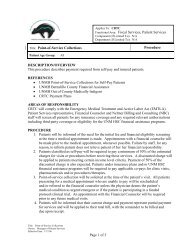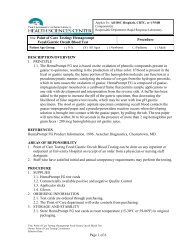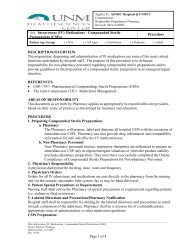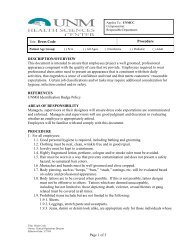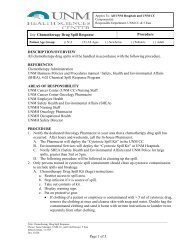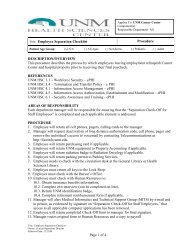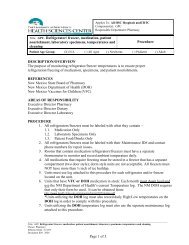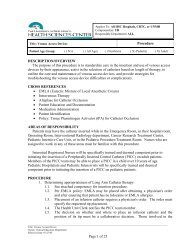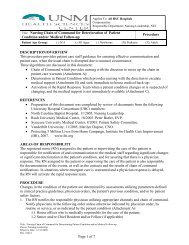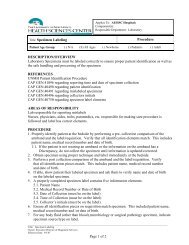Non-OR Universal Protocol/Time Out - UNM Cancer Center
Non-OR Universal Protocol/Time Out - UNM Cancer Center
Non-OR Universal Protocol/Time Out - UNM Cancer Center
You also want an ePaper? Increase the reach of your titles
YUMPU automatically turns print PDFs into web optimized ePapers that Google loves.
PROCEDURE<br />
I. <strong>Non</strong>-Operating Room Invasive Procedures:<br />
Conduct a pre-procedure verification process.<br />
1) Verification of the correct person, correct site, and correct procedure occurs at the following<br />
times:<br />
1.1 At the time the procedure is scheduled<br />
1.2 At the time of preadmission testing and assessment<br />
1.3 At the time of admission or entry into the facility for a procedure, whether elective or<br />
emergent<br />
1.4 Before the patient leaves the preprocedure area or enters the procedure room<br />
1.5 Anytime the responsibility for care of the patient is transferred to another member of the<br />
procedural care team, including the anesthesia providers, at the time of, and during, the<br />
procedure.<br />
2 The preprocedure verification is a process of information gathering and verification.<br />
2.1 The nurse (or physician if the nurse is not involved in the procedure) conducts the<br />
preprocedure verification process to ensure that all relevant documents and related<br />
information or equipment are:<br />
2.1.1 Available prior to the start of the procedure.<br />
2.1.2 Correctly identified, labeled, and matched to the patient’s identifiers.<br />
2.1.3 Reviewed and are consistent with the patient’s expectations and with the team’s<br />
understanding of the intended patient, procedure, and site.<br />
2.2 Preprocedure verification includes:<br />
2.2.1 Correct patient<br />
2.2.2 Correct procedure<br />
2.2.3 Correct site<br />
2.2.4 Procedural and sedation consents<br />
2.2.5 Site marking, if applicable<br />
2.2.6 Relevant documentation<br />
2.2.6.1 For example, history and physical, signed procedure consent form,<br />
nursing assessment, and preanesthesia assessment.<br />
2.2.7 Correct and labeled test results present<br />
2.2.7.1 For example, radiology images and scans, or pathology and biopsy<br />
reports) that are properly displayed<br />
2.2.8 Any required blood products, implants, devices, and/or special equipment for the<br />
procedure<br />
Mark the procedure site<br />
1. Marking the procedure site allows staff to identify without ambiguity the intended site for the<br />
procedure. (For those procedures in which site marking is not required, the other requirements of<br />
the <strong>Universal</strong> <strong>Protocol</strong> still apply.)<br />
2. For all procedures involving incision or percutaneous puncture or insertion, where laterality and/or<br />
level are involved, the intended procedure site is marked.<br />
Note: For procedures that involve laterality of organs, but the incision(s) or approaches may be<br />
from the midline or from a natural orifice, the site is still marked and the laterality noted.<br />
3. The site marking takes place with the patient involved, awake and aware prior to prepping and<br />
draping, if possible.<br />
4. The procedure site is marked by a licensed independent practitioner or other provider who is<br />
permitted by the hospital and qualified through a residency program to perform the procedure. This<br />
_________________________________________________________________________________________________________________<br />
Title: <strong>Universal</strong> <strong>Protocol</strong>/<strong>Time</strong> <strong>Out</strong><br />
Owner: Executive Director, Quality<br />
Effective Date: 12/7/2009<br />
Doc. #2589<br />
Page 2 of 7



